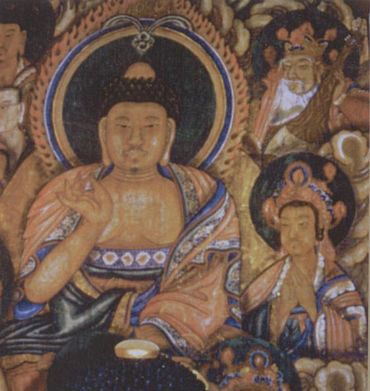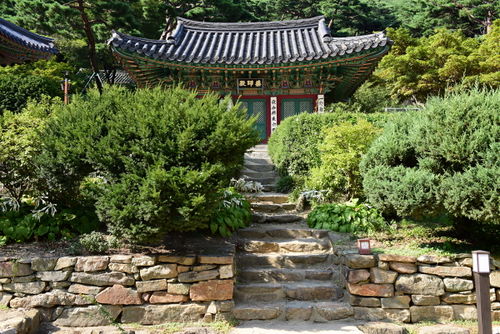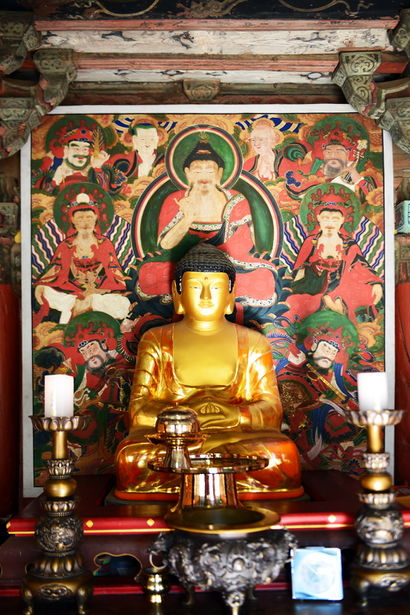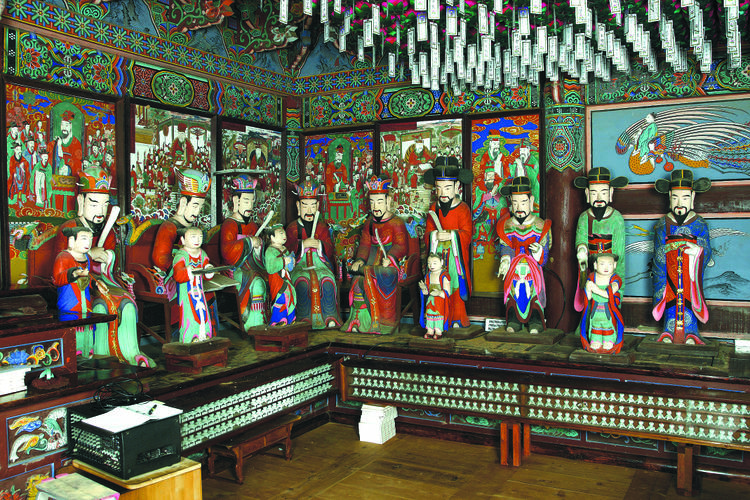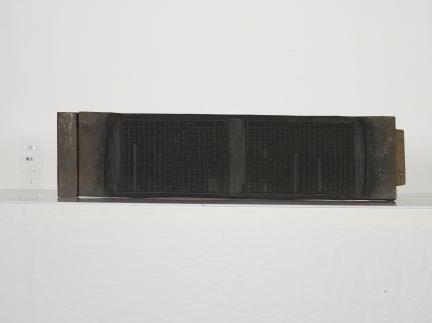"전등사"의 두 판 사이의 차이
(→강화 전등사 목조석가여래삼불좌상(木造釋迦如來三佛坐像)) |
|||
| 34번째 줄: | 34번째 줄: | ||
전등사 대웅보전 목조석가여래삼불좌상은 조성원문을 통하여 정확한 조성연대를 알 수 있을 뿐 아니라, 조각적으로 우수하며, 조각승들과 나타난 발원시주자들의 명단이 잘 전하여 불상(佛像), [[면금(面金)]], [[체목금]], [[체목]], [[오금(烏金)]],[[좌대(座臺)]],[[보단(甫團)]], [[채안(彩安)]], [http://encykorea.aks.ac.kr/Contents/Item/E0023706 복장(腹藏)][https://terms.naver.com/entry.nhn?docId=1591653&cid=50292&categoryId=50292 ] 등 세부적인 시주 항목이 기록된 점 등에서 조선시대 불교조각 연구에 중요한 자료가 된다. | 전등사 대웅보전 목조석가여래삼불좌상은 조성원문을 통하여 정확한 조성연대를 알 수 있을 뿐 아니라, 조각적으로 우수하며, 조각승들과 나타난 발원시주자들의 명단이 잘 전하여 불상(佛像), [[면금(面金)]], [[체목금]], [[체목]], [[오금(烏金)]],[[좌대(座臺)]],[[보단(甫團)]], [[채안(彩安)]], [http://encykorea.aks.ac.kr/Contents/Item/E0023706 복장(腹藏)][https://terms.naver.com/entry.nhn?docId=1591653&cid=50292&categoryId=50292 ] 등 세부적인 시주 항목이 기록된 점 등에서 조선시대 불교조각 연구에 중요한 자료가 된다. | ||
| + | |||
| + | Wooden stone Buddha statue of Jeondeungsa Temple in Ganghwa (木造釋迦如來) | ||
| + | |||
| + | Ganghwa Jeondeungsa Wooden Stone Buddha Statue (Treasure No. 1785) is the second Buddha statue known to date among the paintings created by Suyeon in 1623, a Buddhist statue created by Suyeon, who was active in North Jeolla and South Chungcheong provinces in the first half of the 17th century. The construction of the three Buddhas is a form in which the Buddha and the Medicine Buddha are enshrined, showing the image of the three Buddhas, which were popular throughout the country during the latter part of the Joseon Dynasty. According to the details of Buddha statues, the original Buddha statue shows a graceful and self-assured mutuality, while the left and right Amita Buddha and the pharmacist Buddha are more or less shaped than the original in terms of expression and proportion of their features. The main statue shows a sculptural sophistication compared to the wooden Amita Sutra Sutra Sutra Sutra Sutra Sutra Sutra Sutra in Seocheon, where the expression of "mutuality" is solemn and stable even in terms of overall physical proportion. | ||
| + | |||
| + | Each of the faces of the three Buddhas shows a unique mutuality and also differs in the expression technique of the folds of clothes. This may be the expression of the sculptural individuality of Seongok, who participated in the construction of the Statue of the Three Buddhas at the Temple of Bongseo, Seocheon, along with Su-yeon, a sign-in-law, the Wooden Amita Suta, in 1619, Treasure No. 1751. Yeongcheol, who participated as the third flower garden, followed the supporting performance of the wooden statue of Beocheon Temple in Okgu, and the statue of King Xie Wang (1634, Sunglim Temple in Iksan), and the wooden statue of Pungguk Temple in Namwon, the wooden statue of Sudeok Temple in 1639. | ||
| + | |||
[[파일:1615462.jpg|600px|대웅보전목조석가여래삼불좌상]] [[파일:0000000001659584대웅전후불탱.jpg|370px|대웅전후불탱]] | [[파일:1615462.jpg|600px|대웅보전목조석가여래삼불좌상]] [[파일:0000000001659584대웅전후불탱.jpg|370px|대웅전후불탱]] | ||
2019년 5월 11일 (토) 22:34 판
| 강화 전등사(江華 傳燈寺) | |
|---|---|

| |
| 지정 번호 | |
| 지정일 | |
| 지정 명칭 | 강화 전등사(江華 傳燈寺) |
| 한자 명칭 | |
| 영문 명칭 | Jeondeungsa Temple |
| 분류 | |
| 건립·제작 | |
| 주소 | 인천광역시 강화군 길상면 온수리 635 |
| 위도 | 37.631989 |
| 경도 | 126.484580 |
| 웹사이트 | |
목차
개관
국문 개관
전등사는 고구려 소수림왕 11년(381) 아도화상이 세웠다고 전하지만 고려 중기까지의 역사는 확실히 알 수 없다. 조선 선조 38년(1605)과 광해군 6년(1614)에 큰 불이 일어나 절이 모두 타버려, 그 이듬해 다시 짓기 시작하여 광해군 13년(1621)에 원래의 모습을 되찾았다고 한다.
이 절에는 강화 전등사 목조석가여래삼불좌상, 대웅전과 약사전 그리고 강화 전등사 목조지장보살삼존상과 시왕상, 대웅보전의 수미단, 철종[1], 업경대[2], 청동수조 등 10여건의 문화재가 지정되어 있다.
영문 개관
The temple is presumed to have been built by the Buddhist monk Ado in 381 (the 11th year of the reign of King Sosurim of the Goguryeo Dynasty), though very little is known about its history prior to the mid-Goryeo Dynasty.
It is said that the temple was burnt to the ground by two large fires in 1605 (the 38th year of the reign of King Seonjo of the Joseon Dynasty) and in 1614 (the 6th year of the reign of King Gwanghaegun), and that it was fully restored to its original appearance between 1615 and 1621 (the 13th year of the reign of King Gwanghaegun).
In this temple, about 10 cultural Properties are designated, including "Wooden Seated Sakyamuni Buddha Triad of Jeondeungsa Temple, Ganghwa(Treasure 1785)", "Wooden Ksitigarbha Bodhisattva Triad and Ten Underworld Kings of Jeondeungsa Temple, Ganghwa(Treasure 1786)", "Daeungjeon Hall of Jeondeungsa Temple, Ganghwa(Treasure 178)", and "Yaksajeon Hall of Jeondeungsa Temple, Ganghwa(Treasure 179)".
강화 전등사 목조석가여래삼불좌상(木造釋迦如來三佛坐像)
강화 전등사 목조석가여래삼불좌상(보물 제1785호)은 17세기 전반에 전북, 충남 등지에서 활동하던 수연(守衍)이 수화승으로 참여하여 1623년에 조성한 불상으로 수연이 수화승(首畵僧)으로 조성한 작품들 가운데 지금까지 알려진 두 번째 불상이다. 삼불의 구성은 석가불을 본존으로 아미타불과 약사불이 좌우에 협시하는 형식으로서 조선 후기에 전국적으로 유행했던 삼세불의 도상을 보이고 있다. 불상들의 세부를 보면, 본존 석가불상은 단엄한 자세에 자비한 상호(相好)를 보이며, 좌우의 아미타불상과 약사 불상은 이목구비의 표현이나 비례 면에서 본존상 보다는 다소 조형감이 떨어지는 편이다. 본존상은 상호(相好)의 표현이 근엄하고 전체적인 신체비례 면에서도 안정감이 느껴져 시기적으로 앞서는 같은 수연 작의 서천 봉서사 목조 아미타여래삼존좌상(1619년)에 비해 조각적으로 세련된 감각을 보여준다.
삼세불상의 얼굴은 각각 독특한 상호를 보이고 옷주름 표현기법에 있어서도 차이를 보인다. 이것은 아마도 전등사 삼세불상 조성에 참여한 조각승들 가운데 수화승 수연과 함께 서천 봉서사 극락전 목조아미타여래삼존좌상(1619년, 보물 제1751호) 조성에 참여했던 성옥(性玉)의 조각적 개성이 표현되었을 가능성이 있다. 세 번째 화원으로 참여한 영철(靈哲)은 이후 옥구 보천사 목조지장보살좌상과 시왕상(1634년, 익산 숭림사 봉안)과 남원 풍국사 목조석가여래삼불좌상(1639년, 예산 수덕사 봉안)의 조성에 수연을 따라 참여했으며 성옥에 비해 연배가 아래인 조각승이었을 것으로 생각된다.
전등사 대웅보전 목조석가여래삼불좌상은 조성원문을 통하여 정확한 조성연대를 알 수 있을 뿐 아니라, 조각적으로 우수하며, 조각승들과 나타난 발원시주자들의 명단이 잘 전하여 불상(佛像), 면금(面金), 체목금, 체목, 오금(烏金),좌대(座臺),보단(甫團), 채안(彩安), 복장(腹藏)[3] 등 세부적인 시주 항목이 기록된 점 등에서 조선시대 불교조각 연구에 중요한 자료가 된다.
Wooden stone Buddha statue of Jeondeungsa Temple in Ganghwa (木造釋迦如來)
Ganghwa Jeondeungsa Wooden Stone Buddha Statue (Treasure No. 1785) is the second Buddha statue known to date among the paintings created by Suyeon in 1623, a Buddhist statue created by Suyeon, who was active in North Jeolla and South Chungcheong provinces in the first half of the 17th century. The construction of the three Buddhas is a form in which the Buddha and the Medicine Buddha are enshrined, showing the image of the three Buddhas, which were popular throughout the country during the latter part of the Joseon Dynasty. According to the details of Buddha statues, the original Buddha statue shows a graceful and self-assured mutuality, while the left and right Amita Buddha and the pharmacist Buddha are more or less shaped than the original in terms of expression and proportion of their features. The main statue shows a sculptural sophistication compared to the wooden Amita Sutra Sutra Sutra Sutra Sutra Sutra Sutra Sutra in Seocheon, where the expression of "mutuality" is solemn and stable even in terms of overall physical proportion.
Each of the faces of the three Buddhas shows a unique mutuality and also differs in the expression technique of the folds of clothes. This may be the expression of the sculptural individuality of Seongok, who participated in the construction of the Statue of the Three Buddhas at the Temple of Bongseo, Seocheon, along with Su-yeon, a sign-in-law, the Wooden Amita Suta, in 1619, Treasure No. 1751. Yeongcheol, who participated as the third flower garden, followed the supporting performance of the wooden statue of Beocheon Temple in Okgu, and the statue of King Xie Wang (1634, Sunglim Temple in Iksan), and the wooden statue of Pungguk Temple in Namwon, the wooden statue of Sudeok Temple in 1639.
강화 전등사 약사전 (江華 傳燈寺 藥師殿 )
대웅보전 서쪽에 있는 아담한 약사전(보물 제179호)은 중생의 병을 고쳐준다는 약사여래를 모시고 있는 법당이다.『대웅전약사전개와중수기(大雄殿藥師殿改瓦重修記)』에 조선 고종 13년(1876) 대웅보전과 함께 기와를 바꾸었다는 기록이 보일 뿐 언제 지었는지 확실하게 알 수는 없고 건축 수법이 대웅보전과 비슷하여 조선 중기 건물로 짐작하고 있다.
규모는 앞면 3칸·옆면 2칸이며 지붕은 옆면에서 볼 때 여덟 팔(八)자 모양과 비슷한 팔작지붕이다. 건물 안쪽 천장은 우물 정(井)자 모양이며 주위에는 화려한 연꽃무늬와 덩굴무늬를 그려 놓았다. 지붕 처마를 받치는 수법이 특이하여 당시의 건축수법을 연구하는데 귀중한 자료로 평가되고 있다.
강화 전등사 목조지장보살삼존상 및 시왕상 일괄(木造地藏菩薩三尊像 및 十王像 一括)
강화 전등사 목조지장보살삼존상과 시왕상(보물 제1786호)은 조성원문을 통하여 숭정(崇禎) 9년(1636)이라는 뚜렷한 조성연대를 알 수 있을 뿐 아니라, 대웅전 목조석가여래삼불좌상이 조각승 수연(守衍)에 의해 조성된 지 13년이 지난 뒤에 역시 수연이 수화승이 되어 제작한 상들이다. 지장보살상[4]과 그 좌우에 무독귀왕, 도명존자, 시왕(十王)와 귀왕, 판관, 사자상, 동자상, 인왕상 등 명부전의 권속이 많다보니 조각승도 12명이나 참여하여 수연의 지휘 아래 제작을 맡았던 것으로 보인다. 또한 이 상들의 조성을 위한 시주에 수많은 신도들이 참여한 것으로 보아 당시 전등사 일대의 대대적인 불사(佛事)였음을 짐작할 수 있다.
지장보살상은 방형의 얼굴에 엄중하면서도 자비로운 상호(相好)를 보이며 양 어깨에 걸쳐진 대의 옷자락은 유연한 주름을 이루며 하체로 연결된다. 양손으로는 지물을 들지 않고 엄지와 중지를 맞대어 설법인을 결하고 있는데, 전체적인 비례와 조형감이 우수하다. 지장보살상과 매우 유사한 특징을 보이는 도명존자상은 얼굴표현에서 사실성이 돋보이며, 장삼위에 가사를 입은 착의형식이 단정하다. 수연 조각의 특징을 가장 잘 보여주는 지장보살상과 도명존자 외에도 시왕상과 기타 권속의 여러 상에서 보이는 인간적이면서도 차분한 분위기는 수연 조각의 특징을 잘 나타내고 있다.
조각기법상의 우수성, 조각가와 조성연대에 대한 분명한 기록, 원래부터 전등사 명부전 봉안을 위해 조성된 상이라는 여러 점에서 볼 때 그 가치가 큰 상들이다.
묘법연화경 목판 妙法蓮華經 木板 Printing Woodblocks of Saddharmapundarika Sutra (The Lotus Sutra)
전등사에 소장된 ‘『묘법연화경』 목판(보물 제1908호 )’은 중종 38년(1543) 마니산(摩尼山) 정수사(淨水寺)[5]에서 성달생(成達生) 서체 계열의 인본을 복각하여 1판 4장의 형태로 조성한 것이다. 이 목판은 조선초기부터 16세기까지 성행되었던 성달생 서체 계열의 『묘법연화경』 가운데 시대가 가장 앞서는 목판 자료라는 점에서 가치가 높다. 또한 각 권의 말미와 판면 광곽의 변란 밖에는 『중종실록』 등과 같은 관찬사서 등에서 확인되지 않은 수백 명의 시주질[6]․연화질[7][8] 및 각수 등이 새겨져 있어 16세기 중엽 정수사의 경판 조성과 관련된 역사상, 수록된 승려 등을 통한 불교사적 사실 등 다양한 역사․문화적 실체를 살펴볼 수 있는 학술적 가치도 지니고 있다.
위치
관련 사이트
출처
기여
| 일자 | 역할 | 이름 | 전공 |
|---|---|---|---|
| 2019.4. | 편집 | 김은숙 | 인문정보학 |

